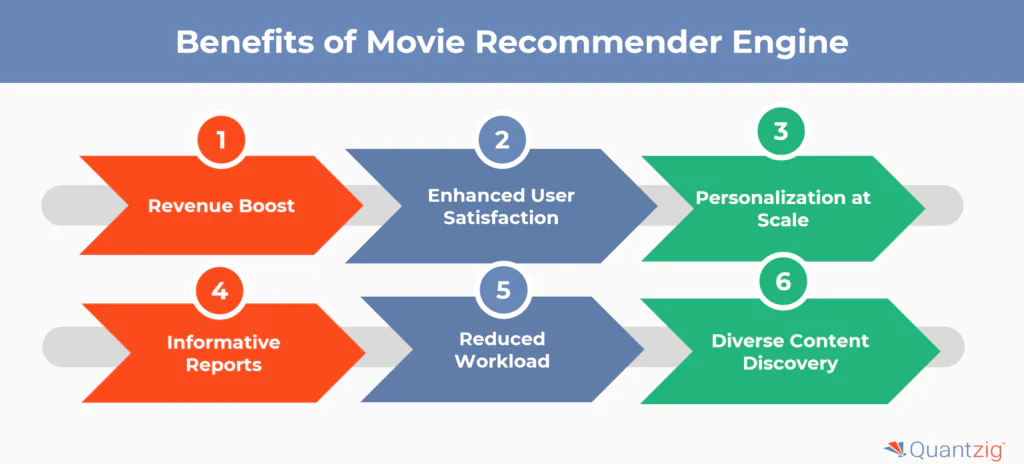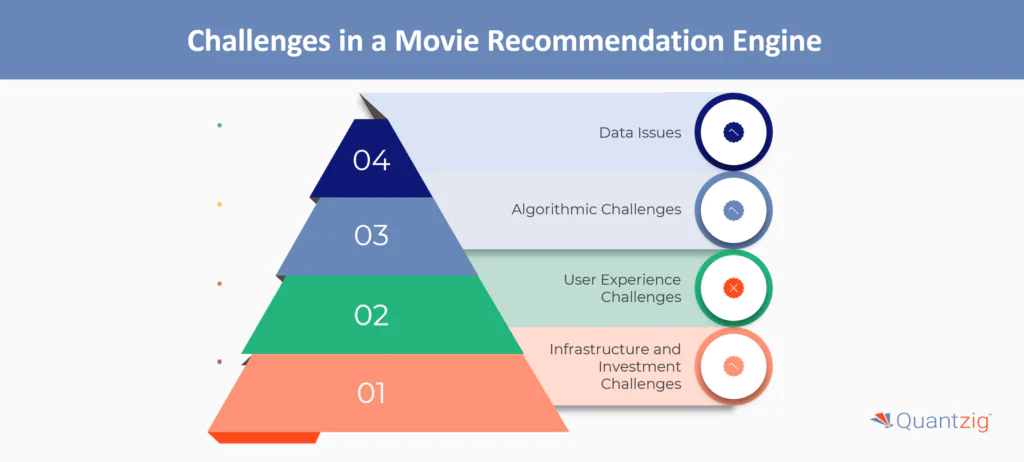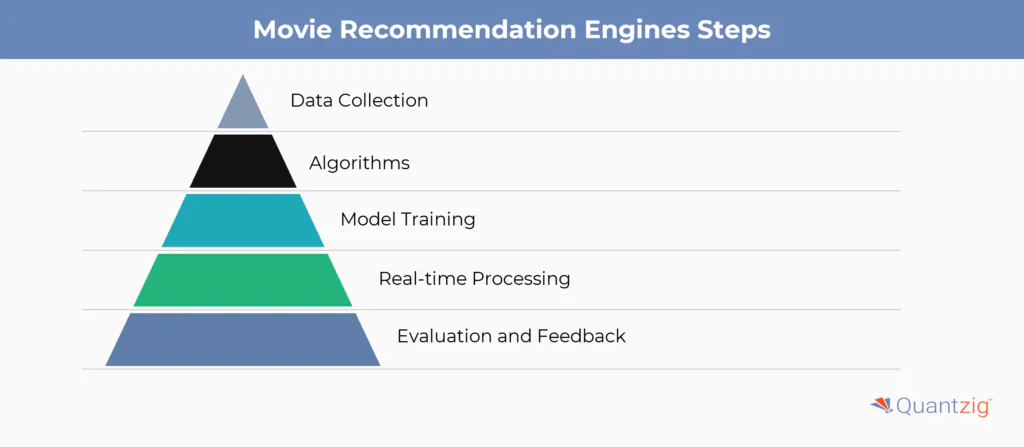Table of Contents
Table of Contents
- Introduction to Movie Recommendation Engine
- What Kind of Data and User Behavior are Captured?
- What are the Key Benefits of Using Movie Recommender Engine?
- Challenges in Developing a Movie Recommendation Engine
- How Movie Recommendation Engines Work
- Technologies Used for Movie Recommendation Engine
- Conclusion
Author: Associate Vice President, Analytics and Data Strategy, Quantzig.
Introduction to Movie Recommendation Engine
The media consumption habit of consumers has primarily shifted from what it used to be. Instead of sitting in front of the TV and watching movies aired by the favorite channels, going to the movie theatre, or renting movie titles recommended by a friend or a store owner, people are watching movies online on apps like Netflix, Amazon Prime Videos, or Hulu. Watching a movie in such apps is only one part of the experience; getting movie recommendations that largely suit user preferences using a movie recommendation engine is the truly remarkable another part of the overall experience. The data analytics algorithms are so impressive that the vast majority of the users end up watching movies and shows from the recommended movies section.
Book a demo to experience the meaningful insights we derive from data through our analytical tools and platform capabilities. Schedule a demo today!
Request a Free DemoWhat Kind of Data and User Behavior are Captured?

To create a movie recommendation engine that is accurate and personalized, enormous volumes and varieties of data should be collected. The data comes from millions and millions of customers that are members of such movie streaming services. Since all content is consumed in the digital medium, all user-behavior related data can be easily collected. As a result, companies can create personas of the users of what their average customers look like. Here are some metrics or user-behavior data that is collected by a movie recommendation engine:
- Movie or show completion rate (how many users completed the full movie)
- Date and time when the content was consumed
- Geographic location and zip code of the user
- Device used to view the movie or show
- Ratings
- Reviews
- Browsing and scrolling behavior
- When a movie is paused, rewind, or fast-forwarded
What are the Key Benefits of Using Movie Recommender Engine?
Here are the key benefits of using a movie recommendation system:
- Revenue Boost: Recommendation engines can drive revenue growth by presenting personalized and relevant movie suggestions, increasing the likelihood of users discovering and watching additional content that aligns with their interests.
- Enhanced User Satisfaction: Tailored movie recommendations that resonate with user preferences can elevate their perception of the platform as attentive to their needs, resulting in heightened satisfaction and a positive overall experience, leading to increased user retention.
- Personalization at Scale: Recommendation systems excel at delivering personalized movie experiences by processing data to create individual user profiles and offer curated suggestions to each viewer.
- Informative Reports: Recommendation engines provide insights into user behavior, preferences, and trends, offering a deeper understanding of similar user engagement data and the effectiveness of different recommendations to drive data-driven decisions.
- Reduced Workload: Automating the process of suggesting relevant movies lightens the burden on employees who would otherwise have to curate recommendations manually, allowing them to focus on other tasks.
- Diverse Content Discovery: Collaborative filtering-based recommendation systems are capable of suggesting a wide range of movies, helping users discover content they might not have found on their own.
In summary, movie recommendation engines provide a powerful way to personalize the viewing experience, boost engagement and retention, and drive revenue growth for streaming platforms. The insights they provide also enable data-driven decisions to optimize the recommendation process.
How is Data Analytics Used to Create a Movie Recommendation Engine?
- When you sign-up for movie streaming services like Netflix or Hulu, apart from asking your general details, they also ask for their interests, movie genres, and rate some of the movies in their database.
- It’s built on the premise that if the algorithm cannot suggest a movie that the customers would like to watch, they will eventually cancel their subscription. So, to keep them interested, they rely on your personal preferences and outside sources to make sure the algorithm suggests a movie that you end up watching. But is the movie recommendation engine efficient?
- Netflix recently tweeted that the recommendation algorithm drives 75% of its viewer activity. Movie streaming services have spent a considerable number of resources on improving the accuracy of their recommendation algorithm, by hosting contests, hiring experts, and investing in infrastructure.
- For instance, by gathering massive amounts of data Netflix realized that a lot of people liked “The Social Network” directed by David Fincher, and the British version of “House of Cards” had a large audience base, and finally those who watched the British version also watching movies with Kevin Spacey and those directed by David Fincher. By factoring in these three data points, Netflix created an American version of House of Cards with both David Fincher and Kevin Spacey.
Also Read: Track Business Progress with Marketing Analytics Dashboard
Experience the advantages firsthand by testing a customized complimentary pilot designed to address your specific requirements. Pilot studies are non-committal in nature.
Request a Free PilotGoing Beyond the Movie Recommendation Engine
The movie recommendation engine is only one aspect where movie-streaming companies can use data analytics. The underlying principles and data analytics technology can be used to analyze user preferences and behavior to customize personalized trailers, promote subscription plans, and provide discounts. Additionally, companies can also decide on which movies to license since renting movies from studios is very expensive. They use metrics which is close to ‘maximum entertainment gained per dollar spent’ to decide which titles to license.
Challenges in Developing a Movie Recommendation Engine
Here are the key challenges in developing an effective movie recommendation engine:
Data Issues
- Data Sparsity: Recommendation systems may struggle when there is insufficient user data or movie metadata available, leading to inaccurate predictions.
- Cold Start Problem: It’s difficult for the system to make recommendations for new users or newly added movies without prior interaction and rating data.
- Scalability: As the user base and catalog of movies grow, the recommendation algorithms need to scale efficiently to handle the increased data volume in real-time.
Algorithmic Challenges
- Trust and Transparency: Users may not fully trust the recommendations if the decision-making process is not transparent or explainable.
- Bias and Stereotyping: Recommendation engines can sometimes reinforce existing biases and stereotypes present in the data used to train them.
- Capturing Dynamic User Preferences: User preferences can change over time, and the system needs to adapt quickly to these changes.
User Experience Challenges
- Information Overload: Providing too many choices can overwhelm users, reducing the effectiveness of the recommendations.
- Onboarding Complexity: The process of collecting user preferences during onboarding can be cumbersome and deter new users.
- Privacy Concerns: Users may be hesitant to share personal data required for personalized recommendations due to privacy concerns.
Infrastructure and Investment Challenges
- Significant Upfront Costs: Building an effective recommendation engine requires substantial investment in data infrastructure, algorithm development, and maintenance.
- Lack of In-House Expertise: Deploying a successful recommendation system often requires specialized skills in areas like machine learning, data science, and user experience design.
Addressing these challenges through innovative algorithms, user-centric design, and robust data infrastructure is crucial for developing a highly accurate and engaging movie recommendation engine.
How Movie Recommendation Engines Work
Movie recommendation engines are sophisticated systems that use various algorithms and data analysis techniques to suggest films to users. Here’s a breakdown of how they function:
1. Data Collection
- User Data: Information about user behavior, such as movie ratings, viewing history, search queries, and interactions with the platform.
- Movie Data: Metadata about movies including genre, cast, director, release year, and user reviews.
2. Algorithms
- Collaborative Filtering: This method relies on the idea that users who agreed in the past will agree in the future. It has two types: User-based Collaborative Filtering: Recommends movies that similar users have liked. Item-based Collaborative Filtering: Recommends movies that are similar to ones the user has liked.
- Content-based Filtering: Recommends movies based on the characteristics of the movies and a user’s past preferences. For instance, if a user likes movies with a certain actor, more movies with that actor will be suggested.
- Hybrid Methods: Combine collaborative and content-based filtering to improve recommendations by leveraging the strengths of both approaches.
3. Model Training
- Machine Learning Models: Algorithms are trained on large datasets to recognize patterns and make predictions. Common models include matrix factorization techniques like Singular Value Decomposition (SVD) and neural networks.
4. Real-time Processing
- Dynamic Updates: The recommendation engine continuously updates its suggestions based on real-time user interactions and newly available content.
5. Evaluation and Feedback
- Performance Metrics: Engines are evaluated using metrics such as precision, recall, and F1 score to ensure accuracy and relevance of recommendations.
- User Feedback: User feedback loops help in refining and improving the recommendation algorithms.
Technologies Used for Movie Recommendation Engine
Here are the key technologies and approaches used in movie recommendation engines:
- Collaborative Filtering: This is a common technique used in movie recommendation systems. It analyzes user ratings and preferences to identify similar users and recommend movies that similar users have enjoyed.
- Content-Based Filtering: This approach recommends movies based on the similarity of their content features, such as genres, actors, directors, plot summaries, etc. It focuses on the attributes of the movies themselves rather than user preferences.
- Matrix Factorization: This is a machine learning technique used to decompose the user-item rating matrix into user and item latent factors. These factors can then be used to predict ratings and make recommendations.
- Semantic Search: Some advanced recommendation engines like Jinni use semantic search capabilities to understand the user’s natural language queries about movies and return relevant recommendations.
- Hybrid Approaches: Many modern recommendation systems combine multiple techniques like collaborative and content-based filtering to leverage the strengths of each approach.
- Machine Learning Models: Recommendation engines often employ supervised and unsupervised learning models trained on user data and movie metadata to power their recommendation algorithms.
- Big Data and Infrastructure: Streaming platforms like Netflix leverage massive amounts of user data and invest heavily in scalable infrastructure to power their sophisticated recommendation systems.
In summary, movie recommendation engines utilize a variety of data mining, machine learning, and information retrieval techniques to provide personalized and relevant movie suggestions to users. The specific technologies employed can vary across different platforms and use cases.
Notable Movie Recommendation Engines Examples
- Rotten Tomatoes
- IMDb
- Netflix
- Movielens
- Hulu
- Nanocrowd
- Jinni
- Taste Kid
- Metacritic
- Amazon Prime
Also Read: Maximizing Marketing Budgets with Campaign ROI Analysis
Get started with your complimentary trial today and delve into our platform without any obligations. Explore our wide range of customized, consumption driven analytical solutions services built across the analytical maturity levels.
Start your Free Trial TodayConclusion
Movie recommendation engines like Netflix, Hulu, Amazon, YouTube, and Rotten Tomatoes leverage advanced data analytics techniques, including content-based filtering, memory-based collaborative filtering, and model-based collaborative filtering. Platforms such as Movielens, Flixster, IMDb, Criticker, Taste Kid, and Jinni utilize these methods alongside deep learning and neural networks. Utilizing datasets like the MovieLens Dataset, these engines provide personalized recommendations across genres such as drama, comedy, and action. This integration of sophisticated algorithms and extensive data enhances user experience by delivering highly relevant and tailored movie suggestions.






